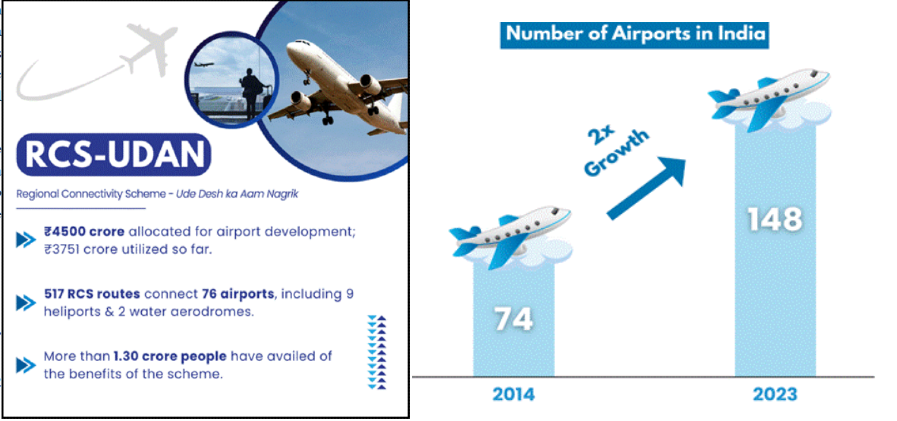Indian Economy
India's Ambitious Airport Expansion Plan
- 13 Jul 2024
- 10 min read
For Prelims: Airports Authority of India, UDAN Scheme, Directorate General of Civil Aviation
For Mains: Status of the Aviation Industry in India, Measures to Re-energize the Aviation Sector in India, Vision 2047
Why in News?
India plans to double its number of operational airports to 300 by 2047, driven by an eightfold increase in passenger traffic. This ambitious expansion involves developing existing airstrips and constructing new airports across the country.
What are the Factors Driving this Expansion?
- Development of Existing Airstrips: The Airports Authority of India (AAI) plans to develop 70 airstrips into airports capable of handling narrow-body aircraft like A320 or B737.
- Existing airstrips at Mandavi (Gujarat), Sultanpur (Uttar Pradesh), Tura (Meghalaya), and Chhindwara (Madhya Pradesh) can be upgraded for small aircraft. Nearly 40 airstrips are slated for development to accommodate smaller aircraft.
- New airports will be built if existing airstrips cannot be developed or if there is no civilian airport within 50 km.
- New greenfield airports may be constructed in Kota (Rajasthan), Parandur (Tamil Nadu), Kottayam (Kerala), Puri (Odisha), Purandar (Maharashtra), Car Nicobar, and Minicoy (Andaman and Nicobar Islands).
- Projected Passenger Traffic Growth: Passenger traffic is expected to increase eightfold, from 376 million to 3-3.5 billion annually by 2047. International traffic may constitute 10-12% of this growth.
-
The plan is part of Vision 2047, aiming to accommodate this massive increase in air travel demand.
-
- UDAN Scheme Implementation: Improving connectivity to tier-II and -III cities through schemes like UDAN (Ude Desh ka Aam Nagrik).
- In 2014, there were 74 operational airports, which has now increased to 148. Under the UDAN scheme, 68 underserved/unserved destinations, including 58 airports, 8 heliports, and 2 water aerodromes, have been connected. It has provided air connectivity to over 29 states/union territories.
- India's aviation infrastructure is the overcrowding of airports. With the surge in air travel demand, major airports across the country are operating beyond their designed capacities.
- Rising Income Levels: India's economy is projected to grow substantially by 2047, with per capita income expected to reach USD 18,000-USD 20,000. This economic growth is a crucial factor driving aviation expansion.
- Higher disposable incomes make air travel more affordable for a larger segment of the population.
- A growing middle class is likely to choose air travel over other modes of transportation for both business and leisure.
- Increased business activities and tourism resulting from economic growth will further boost demand for air travel.
- Anticipated Growth in Air Cargo: While passenger traffic is a primary focus, the expansion also considers the growing air cargo sector.
- E-commerce growth is driving demand for efficient air freight services.
- India aims to become a major player in the global air cargo market.
- New and expanded airports will have enhanced cargo-handling capabilities.
- Development of Major International Hubs: India aims to position its major airports as international hubs, competing with established hubs in the Middle East and Southeast Asia.
- This aspiration is driving the expansion and modernization of existing airports, as well as the development of new ones to attract more international airlines and passengers, increase transit traffic, and boost tourism and business travel to India.
- Under-Penetration of Air Travel: India's aviation market is one of the largest in the world, but air travel penetration is still low compared to developed countries.
-
The AAI's assessment provides interesting comparisons with other major markets: China (2019): 0.47 trips per capita per annum (GDP per capita: USD 10,144), USA: 1.2-1.3 trips per capita per annum (GDP per capita: USD 20,000) and India's projection for 2047: 1 trip per capita per annum (Estimated GDP per capita: USD 18,000-USD 20,000)
-
This creates a huge growth opportunity as income levels rise and air travel becomes more accessible, there is expected to be a surge in demand.
-
The expansion plan is designed to anticipate and prepare for this expected growth in air travel adoption.
-
Airports Authority of India (AAI)
- The AAI is a statutory body under the Directorate General of Civil Aviation, Ministry of Civil Aviation, Government of India. It was formed in 1995, by merging the National Airports Authority and the International Airports Authority of India.
- It also provides Air Traffic Management Services over Indian airspace and adjoining oceanic areas.
- The functions of AAI include airport development, airspace control, passenger and cargo terminal management, and provision of communication and navigation aids.
- AAI provides air navigation services over 2.8 million square nautical miles of air space.
What are the Challenges for the Expansion of Airports in India?
- Land Scarcity: Increasing urbanization is exacerbating the land shortage, particularly in larger towns and cities. The cost and availability of land may impact the viability of many airport projects.
-
Massive Investment Requirements: India needs more than USD 40 billion in airport development by 2047.
-
Total expenditure could reach USD 70-80 billion when including upgrades to airspace infrastructure and ground transportation.
-
- Infrastructure Constraints: Many existing airports are reaching or have reached saturation, including critical hubs like Mumbai. Several cities urgently need new airports or significant expansions of existing ones; this can hinder the development process of new airports.
- Air Navigation Services (ANS) Infrastructure: Significant investments (possibly up to USD 6-7 billion) are needed in ANS technology, people, and training.
- Surface Transportation: Investment required in ground transportation to/from airports could be almost as much as that in the airports themselves.
- Lack of adequate surface connectivity could impact the viability and convenience of new airports.
- Environmental Concerns: Airport expansions often face opposition due to potential environmental impacts, including noise pollution and habitat disruption.
Way Forward
- Integrated Land Use Planning: Create special economic zones around airports, similar to "Aerotropolis" concept, which combines the airport with business, logistics, and residential areas. This can help justify land acquisition and maximize economic benefits.
- Multi-Modal Transportation Integration: Develop integrated transportation hubs like Frankfurt Airport's long-distance train station, which connects the airport directly to the national rail network. This addresses surface transportation challenges and enhances airport accessibility.
- Green Airport Design: Prioritize sustainable and environmentally friendly airport designs. Adopt Oslo Airport's approach of using sustainable materials and other eco-friendly technologies.
- Oslo Airport in Norway uses biomass heating systems to combat harsh Nordic winters, utilising organic materials for warmth.
- Design airports with flexibility for future expansion and changing needs and adaptations to changing aviation trends.
- Public-Private Partnerships (PPP): Leverage PPP models to attract investment and expertise. Develop a robust PPP framework similar to build-operate-transfer (BOT) model This can help address the massive investment requirements while ensuring efficient operation.
- Capacity Enhancement of Existing Airports: Maximizing capacity through technological and operational improvements. This includes implementing advanced air traffic management systems and optimizing runway usage, to increase capacity without building new runways.
- Smart Airport Technologies: Leverage cutting-edge technologies to enhance efficiency and passenger experience. Adopt technologies like biometric boarding and automated baggage handling systems to improve operational efficiency and capacity.
|
Drishti Mains Question: Q. Discuss India's Vision 2047 for airport infrastructure expansion, and how does it aim to meet the anticipated increase in passenger traffic? |
UPSC Civil Services Examination, Previous Year Questions (PYQs)
Mains
Q. Examine the development of Airports in India through joint ventures under Public–Private Partnership (PPP) model. What are the challenges faced by the authorities in this regard? (2017)







